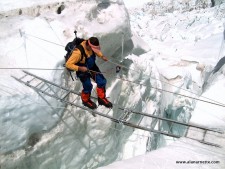
Climbers are working hard to adjust to the altitude and their new environment. Multiple reports are coming in on restless nights, high heart rates, low oxygen saturation and the usual litany of GI issues. All normal.
The weather is also dominating reports with snow, low clouds and winds covering Base Camp and obscuring the top of Everest. Dave Hahn posted an amazing picture on Facebook of a wave cloud over the summit. But as usual, the next day will probably be crystal clear.
Edita Nichols climbing with Altitude Junkies has a nice post on their early journey through Tibet. It reminds me of my first trip there in 1998!
The drive from Zongmu to Nyalam was rather quick, about an hour drive from Zongmu which is on the Chinese-Nepalese border, along the Friendship Highway. Nyalam is not a very nice place, a single street town, damp and grey. Last night it started even snowing. The only way to stay warm is in your sleeping bag! The altitude here is about 3,500meters and the air feels thiner. From here, you can see a range of hills in the distance.
Those arriving at Base Camp on the South are experiencing life on the glacier. Chris trekking in with the IMG team made this observation:
While I’d expected it to be cold I hadn’t expected it to be quite so noisy. Avalanches and rockfalls from the surrounding peaks were frequent, and sounded rather like a rumble of thunder. The often strong winds made a similar sound as they barreled up the valley, so that it was sometimes only possible to tell the difference when the wind buffeted the tent – or not. The shifting of the glacier itself made sounds ranging from the gentle creaks of an old house when the heating goes off, to the slam of a car door, to a gunshot – the latter more than a little disconcerting when it came from directly beneath my tent, and doubly so when I could feel it. I consoled myself that the Khumbu is a ‘dry’ glacier, so a crevasse was unlikely to open up beneath me. But there was still the regular sound of a ball smashing through a greenhouse whenever the movements of the glacier cracked the ice on one of the many frozen pools. With all that racket, I can’t say I slept well while at Base Camp!
Ladders
One of the famous features of climbing Everest are the ladders used to cross crevasses. In the Khumbu Icefall, there are between 20 and 30 crevasses. In the Western Cwm, there can be a few more and finally a couple at the base of the Lhotse Face. One the north side, there are several near crampon point as climbers ascend to the North Col.
Most Nepal side climbers will make at least four round trips through the Icefall meaning they will cross over 200 crevasses.
The ladders are not always straight across a crevasse, in fact almost never. They can go down, straight up, be positioned at an angle, anything but horizontal. There can be dual ladders in high traffic areas. Sometimes an up ladder and a down ladder.
Most teams will practice crossing ladders with their full size 8000 meter boots and crampons on while at Base Camp just to get the feel for it. But the experience is “interesting” as in what you would read from a fortune cookie.
Approaching the ladder, you pause for an inspection. How many ladders are lashed together? Not too bad if only one, but three, four or more, it sinks in the middle, it bounces. Watching a Sherpa crossing ahead, you see the wobble – left, right, up, down. It is 3D.
The safety lines are in place so you look at the anchors, the place where they are secured to the ground, or more accurately, the snow or ice. The thin nylon line is tied in a squirrelly knot through a hole in an piece of bent aluminum – a picket. That’s all? Looking across the crevasse you see the rope tied to an ice screw, but in the hot sunlight the hole has melted out and the ice screw bobs freely.
Knowing you have little choice, you approach the ladder as one would approach a live chicken. Carefully, slowly, you move your feet towards the edge. Bending over, you grab the right hand safety line, then with your other hand you press the locking mechanism of your carabiner inwards and clip onto the line. Your ‘biner is tied to your harness with a short piece of nylon webbing. Repeating this procedure, you are now hooked on both safety lines. Your life is now in the hands of the makers of nylon.
Your crampon’s front points jut out from your boot as you focus your eyes on the first rung. The question is whether to put the mid part of your sole on the rung or to gingerly put your front points on one rung and the back of your boot on the trailing rung. The latter runs the risk of being caught when you lean forward, forcing the rung tightly against your crampons. Only a Cirque du Soleil move would allow you to free yourself.
Seeing the Sherpas make this move gives you confidence so you move forward. The right boot settles on the ladder, then your left foot moves quickly in place. You hold onto the ropes with a grip so tight that if you fell, your shoulder would dislocate before your grip would release.
Your hands are slightly behind you to pull the line taught. All of a sudden, the line goes tight from both sides. Teammates have squatted at both ends of the ladder to pull the rope tight making it more of a rail. You appreciate this and return the favor at the next crossing.
One step is followed by the next and then a third. Your eyes focused on the ladder, your boot, your knee – anything other than the seemingly bottomless pit below you. In the middle of the span, you realize you have not taken a breath. At 18,000 feet, this is a big mistake. You pause and take a big breath. Looking up, you see Sherpas, strangers and a black dog looking at you, wondering. You wonder as well.
A few more steps, your foot reaches the snow covered ground. You take another deep breath. Unclipping, you stand up straight, you had been slouching the entire time. Your mother would be unhappy. Looking around you feel good. Only 199 more ladder crossing to go.
Climb On!
Alan
Memories are Everything

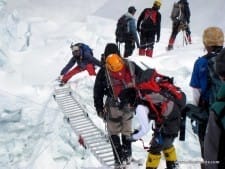
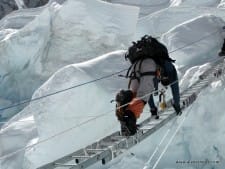
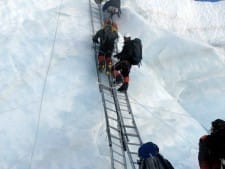
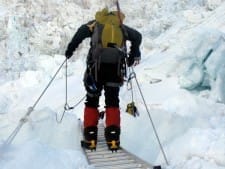
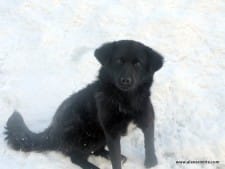
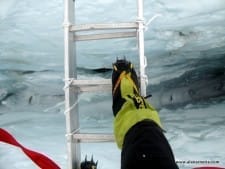
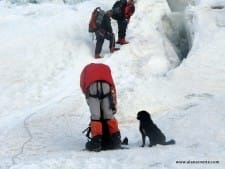
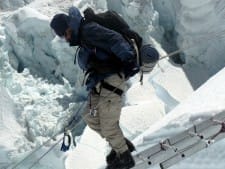
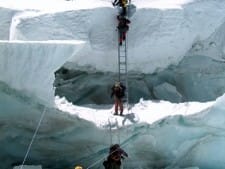
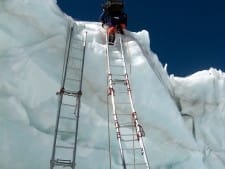
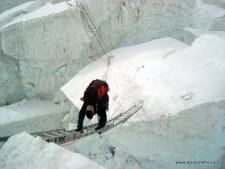
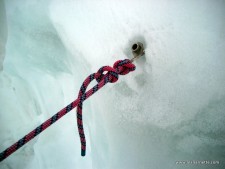
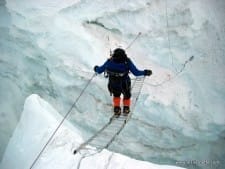


12 thoughts on “Everest 2013: Crossing the Ladders of Everest”
Thanks for the great description about the ladders and the process of going across them. It gives “us” the “regular people”: family members and friends of those going thru that amazing experience, a clear idea of what they are doing, which otherwise we wouldn’t even have a concept about it, except for seeing the ladders and people walking on them. Prayers for all attempting to climb Everest are always present and ongoing! Alan’s website is awesome. Thanks for all the amazing updates!
What a fantastic description!! You could write a Bond novel you know lol 🙂
Thank you Alan . It is great to read and feel that I am there . Enjoying your writing .
Take care . Happy climbing .
My young guides friend was bounced off one last year. A 2nd sherpa took to the same extended ladder, unsecured and under load as the first guy was – over the side he went. I’ve always wondered why they don’t place some sort of suitable treadway over the horizontal ladders where they can?
Would be nice Craig but not very practical. Ladders are lightweight, relatively easy to lash onto a backpack and move at 18,000′. Also, with the Icefall moving up to 3 feet a day, a lot of ladders are lost or damaged throughout the season. However, back in the early days of Everest, they hauled logs into the Icefall to span crevasses!
Great descriptions, as always.
What a vivid description, Alan! I felt my stomach knotting up trying to get across that crevasse. Very curious about the black dog – who feeds it? Where it sleeps at night? Does it belong ti anyone. Is it there from year to year?
There are a lot of “black dogs” in the Khumbu 🙂 The one in the picture was from 2002 but I saw others in 2003/8/11. They follow the climbers and trekkers from Gorak Shep (high village) to EBC looking for food. Sometimes people will let them sleep in their tent (not advised) but mostly they scrounge and sleep wherever. Occasionally, they cross the ladders, amazingly, and go to C1 or C2 where eventually a Sherpa will put them in their pack and take them back down. Everyone tries to discourage the dogs but hey are hardy souls.
The thought of going through the icefall terrifies me – the suspension bridges through the Khumbu were bad enough! Big drops right beneath my feet have a very disconcerting effect on me and I can’t help myself looking down when I subsequently freeze! Is it true to say that ascending from the North Side is not so harsh from this point of view.
in 2010 Nyalam was quite a nice place. The hotel we stayed in had heat, hot showers and there were also heat lamps in the shower. So it was a very big contrast to Zangmu and Tingri. There was a water filter in the room and none of us got sick drinking it. we really enjoyed the stay in that place.
Holy Carp… Your wonderful description of the ladder challenges made my heart speed up Alan! And Chris with IMG writing about the sounds at night is stunning especially how I related to this sound from growing up in a huge old creaky house with tall iron radiators…
” the gentle creaks of an old house when the heating goes off, ” Thank you each and every day for my arm chair journey with you on Everest….
Remember well my “first Icefall” ladder crossing deep on the night within the bowels of the that hellish maze of Seracs and Crevasses. Pause I did indeed Alan! 😉
Comments are closed.